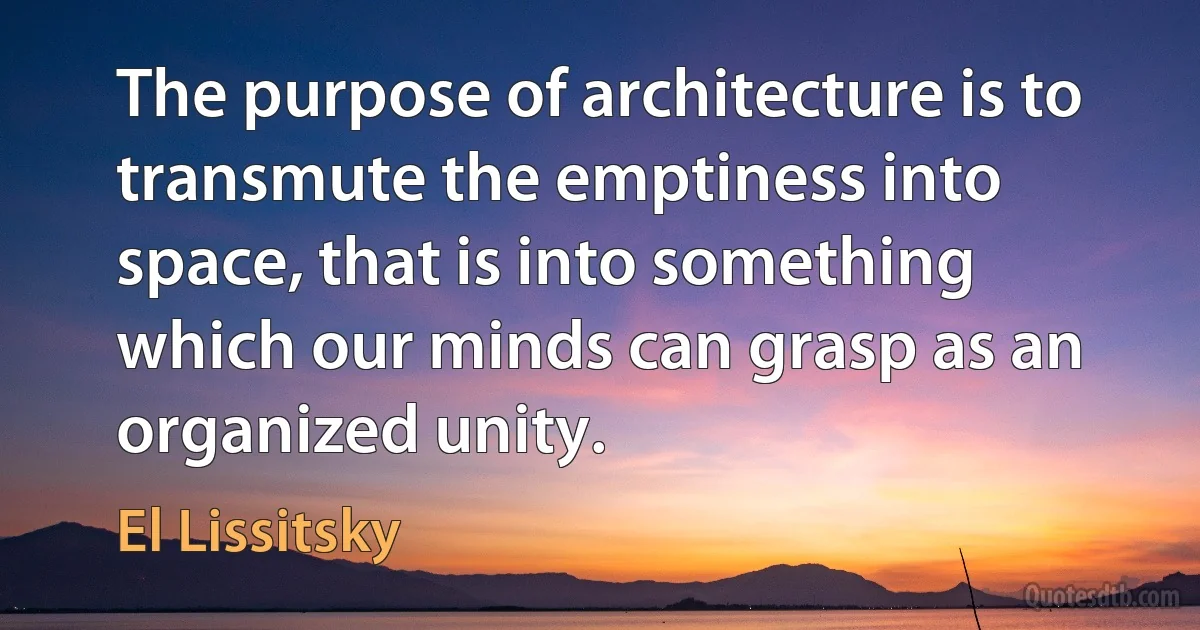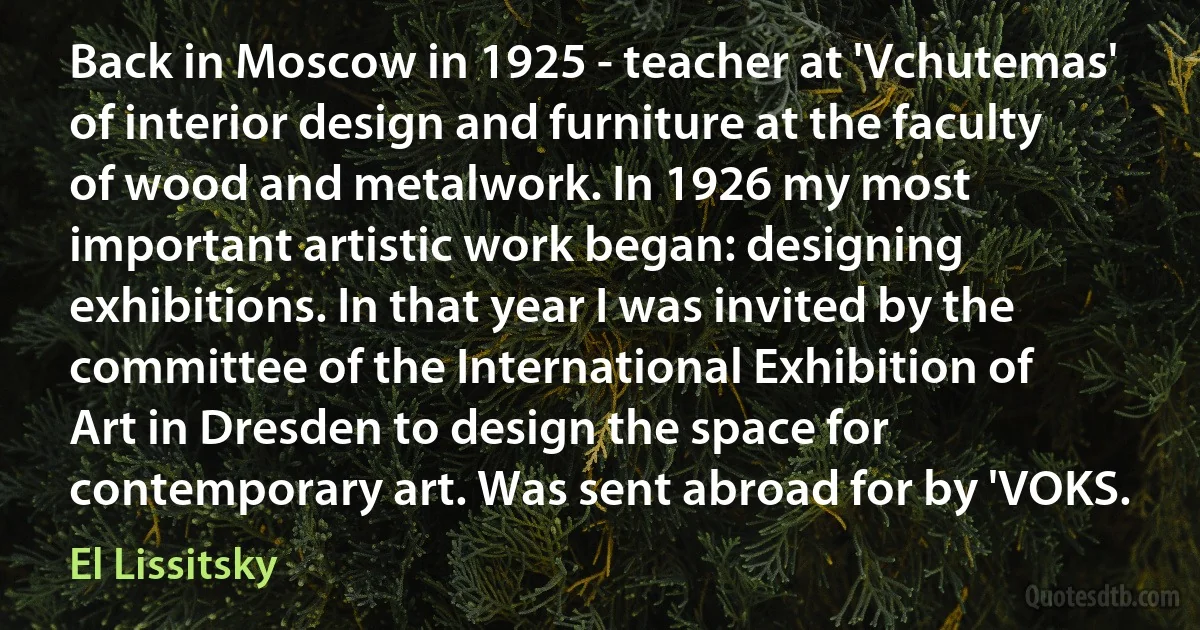El Lissitsky quotes
During my stay in Germany in 1922 I collaborated with the writer Ehrenburg, on the Magazine 'Veshch' (Gegenstand) [= Object] (first pro-Soviet edition). [I] Took part in organizing the First Russian Art Exhibition 1922-23 in Berlin and Amsterdam. My works were purchased by European and American collectors and museums. The museum in New York acquired a 'Proun' from the Soviet Exhibition. At this time, in 1923, I contracted pulmonary tuberculosis.

El Lissitsky
The second conception of the world via the medium of matter required both a visual and a tactile perception of things. In this case the whole design process tends to emanate from the specific characteristics of the respective medium used. The leader of this movement (Tatlin) assumed.... that the intuitive and artistic mastery of materials would lead to inventions on the basis of which objects could be constructed. He believed he could prove this theory with his design for the 'Monument to the Third International' (1920), [never built]. He accomplished this task without having any special technical knowledge of construction.

El Lissitsky
The term A[rt] resembles a chemist's graduated glass. Each age contributes its own quantity: for example, 5 grams of the perfume 'Coty' to tickle the nostrils of the fine gentry. Or another example, 10 cc of sulfuric acid to be thrown into the face of the ruling classes. Or, 15 cc: of some kind of metallic solution that later changes into a new source of light.. ..[as Lissitzky goes on to say] This A[rt] is an invention of the mind, i.e. a complex, where rationality is fused with imagination.

El Lissitsky
We must take note of the fact that the artist nowadays is occupied with painting flags, posters, pots and pans textiles and things like that. What is referred to as 'artistic work' has on the vast majority of occasions nothing whatever to do with creative effort: and the term 'artistic work' is used in order to demonstrate the 'sacredness' of the work which the artist does at his easel. The conception of 'artistic work' presupposes a distinction between useful and useless work and as there are only a few artists buyers can be found even for their useless products. The artist's work lies beyond the boundaries of the useful and the useless.

El Lissitsky
The pace of life has increased in the last few decades just as the speed of the motor bicycle has been exceeded many times over by the aeroplane. After art passed through a whole series of intermediate stages it reached cubism where for the first time the creative urge to construct instinctively overcame conscious resolve.. ..from this point the picture started to gain stature as a new world of reality and in this way the foundation stone for a new representation of the shapes and forms of the material world was laid.

El Lissitsky
In America the architect has a direct and continuing relationship with technology. Perhaps this is why he does not ask more from technology than it can offer. In our country [Russia] it is still impossible to have such urban complexes as are found in Paris, Chicago, or Berlin. It is through technology that we can build a bridge to all the most recent achievements, which is what made it possible for our country to pass directly from the hoe to the tractor without having to travel the long path of historical development. That is why we want to introduce the most modern methods of building and construction into our country - and why we see the works and designs of both the 'formalists' and the 'constructivists' as a radical experiment in the manipulation of construction.

El Lissitsky
In 1935 I was appointed leading artist of the All-Soviet Agricultural Exhibition. I opposed the errors of the first leader, and resigned. Afterwards, while I was still in the sanatorium, I took over the design of the main building. The design of the main hall has been done according to my idea until now. From 1931 on, I was leading artist-architect of the 'Permanent Building Exhibition'. But as the years went by, my health deteriorating, I had less and less energy left for this type of commission, such as the realization of large-scale exhibitions. I still succeeded in designing the project for the museum-exhibition of the Ministry of 'Social Security'.

El Lissitsky
We have had enough perpetually hearing MACHINE MACHINE MACHINE MACHINE. In the repetition of the word MACHINE, we read the modern artist's ambivalent relationship to mechanical reproduction: on the one hand, the rigorous linear order and uniform application of ink presented by the thrice-repeated type written line celebrates sterility; and on the other hand the content of the sentence itself bemoans the transformation of the industrial paradigm into an aesthetic cliché.

El Lissitsky
Therefore THE IDEA OF 'ARTISTIC WORK' MUST BE ABOLISHED AS A COUNTER-REVOLUTIONARY CONCEPT OF WHAT IS CREATIVE and work must be accepted as one of the functions of the living human organism in the same way as the beating of the heart or the activity of the nerve centers, so that it will be afforded the same protection.

El Lissitsky
The path of the PROUN does not lie within the narrowly limited, fragmented, and isolated scientific disciplines - the builder consolidates them all together in his own experimental investigation. The path of the PROUN is not the incoherent approach of separate scientific disciplines, theories, and systems, but is rather the straightforward path of learned influence over reality.

El Lissitsky
Painting.... turned to the design of purely abstract volumetric forms... Since the leading exponent of the color theory was a painter (Malevich), he failed to recognize the objective reality of the world [in architecture! ]. Because he always looked at it only through his own eyes, he remained trapped in a world devoid of real objects. The broader implications of this had to be developed by us, the architects.

El Lissitsky
In the future it will be necessary on the one hand to establish a balance between the intimate and individualistic demands for housing, and on the other to take full account of general social conditions. Thus, for example, cooking should be transferred from the private single kitchen into the communal cooking laboratory; the main meal should be consumed in public eating establishments; and the rearing of children should become the responsibility of the kindergarten or the school... Presently our goal is the transition from housing as an agglomeration of many private dwellings to housing communes.

El Lissitsky
I was born on 23 November 1890 in a village in the province of Smolensk. Grew up in Smolensk, in the home of my grandfather, a cap-maker. Completed secondary school there. At the age of 15 I started earning money by giving drawing lessons. Passed the entrance examination of the art academy in Leningrad but, being a Jew, was not admitted due to the restricted percentage.

El Lissitsky
This dynamic architecture provides us with the new theater of life and because we are capable of grasping the idea of a whole town at any moment with any plan the task of architecture - the rhythmic arrangement of space and time - is perfectly and simply fulfilled for the new town will not be as chaotically laid out as the modern towns of north and south America but clearly and logically like a beehive..

El Lissitsky
This is the way in which the artist has set about the construction of the world - an activity which affects every human being and carries work beyond the frontiers of comprehension. We see how its creative path took it by way of cubism to pure construction, but there was still no outlet to be found here.

El Lissitsky
We analyzed the first stage of our construction, confined to two-dimensional space, and found it to be as durable and resistant as the earth itself. We build in this space just as we would on the ground, and therefore must take as our point of departure the concepts of gravity and force of attraction, as the foundation of everything built on the land. In PROUN the reciprocity of the effects of gravity [Newton, 'for every action an equal and opposite reaction'] manifests itself in a new capacity. We see that on the surface (plane) of the picture, the PROUN ceases to exist as such and becomes a building surveyed from every direction - considered from above or examined from below. The result of this turns out to be the destruction of the single axis that leads to the horizon.

El Lissitsky
For us [the young artists in Vitebsk, before 1920] Suprematism did not signify the recognition of an absolute form which was part of an already completed universal system, on the contrary; here stood revealed for the first time in all its purity the clear sign and plan for a definite new world never before experienced - a world which issues forth from our inner being and which is only now in the first stages of its formation, for this reason the square [ Malevich's Black and Red Square ] of suprematism became a beacon.

El Lissitsky



